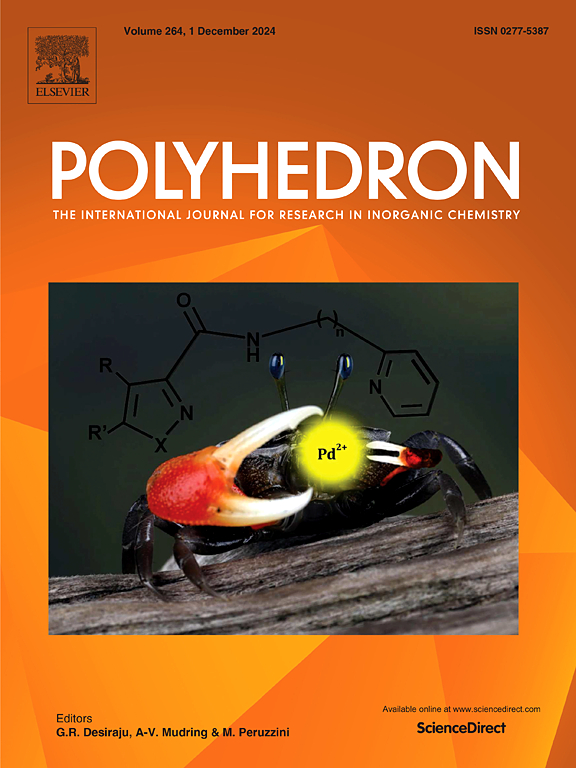新型Cu(II)希夫碱配合物的晶体结构表征、分子对接和ADMET分析:对SARS-CoV-2和HPV的抗病毒特性
IF 2.4
3区 化学
Q2 CHEMISTRY, INORGANIC & NUCLEAR
引用次数: 0
摘要
我们合成并表征了两种新的混合配体Cu(II)配合物:[Cu(SB1)(py)]ClO4和[Cu(SB2)]ClO4。SB1配体是由2,2-二甲基-1,3-丙二胺的一个氨基与水杨醛缩合而成的三齿n20型不对称希夫碱。相反,四齿n30型SB2是由剩余的氨基与甲基-2-吡啶酮进一步缩合而成的。通过单晶x射线晶体学(SCXRC)证实了[Cu(SB2)]ClO4的晶体结构。采用分子对接和ADMET分析来评估这些复合物及其希夫碱配体与SARS-CoV-2 (PDB ID: 6LU7)和人乳头瘤病毒(HPV, PDB ID: 4XR8)相关蛋白的相互作用。此外,还纳入了抗病毒药物famciclovir(用于HPV)和baricitinib(用于SARS-CoV-2)进行比较。分子对接结果表明,[Cu(SB1)(py)]ClO4与6LU7具有较高的负估计自由结合能(EFBE)值,且[Cu(SB2)]ClO4的二聚体形式与4XR8的结合性能最佳。计算机ADMET评估表明,这些复合物及其相应的希夫碱配体具有良好的药物样性质,突出了它们作为治疗候选物的潜力。本文章由计算机程序翻译,如有差异,请以英文原文为准。

Crystal structural characterization, molecular docking and ADMET analysis of new Cu(II) Schiff base complexes: Antiviral properties against SARS-CoV-2 and HPV
We synthesized and characterized two new mixed-ligand Cu(II) complexes: [Cu(SB1)(py)]ClO4 and [Cu(SB2)]ClO4. The SB1 ligand is a tridentate N2O-type unsymmetrical Schiff base formed from the condensation of one amino group of 2,2-dimethyl-1,3-propanediamine with salicylaldehyde. In contrast, the tetradentate N3O-type SB2 is derived from further condensation of the remaining amino group with methyl-2-pyridyl ketone. The crystal structure of [Cu(SB2)]ClO4 was confirmed via single-crystal X-ray crystallography (SCXRC). Molecular docking and ADMET analyses were employed to evaluate the interactions of these complexes and their Schiff base ligands with proteins associated with SARS-CoV-2 (PDB ID: 6LU7) and Human Papillomavirus (HPV, PDB ID: 4XR8). Additionally, the antiviral drugs famciclovir (for HPV) and baricitinib (for SARS-CoV-2) were included for comparison. The molecular docking results revealed that [Cu(SB1)(py)]ClO4 exhibited significant binding affinity, indicated by higher negative estimated free binding energy (EFBE) values with 6LU7 and the dimer form of [Cu(SB2)]ClO4 shows the best performance with 4XR8. In silico ADMET assessments suggest that these complexes and their corresponding Schiff base ligands possess favorable drug-like properties, highlighting their potential as therapeutic candidates.
求助全文
通过发布文献求助,成功后即可免费获取论文全文。
去求助
来源期刊

Polyhedron
化学-晶体学
CiteScore
4.90
自引率
7.70%
发文量
515
审稿时长
2 months
期刊介绍:
Polyhedron publishes original, fundamental, experimental and theoretical work of the highest quality in all the major areas of inorganic chemistry. This includes synthetic chemistry, coordination chemistry, organometallic chemistry, bioinorganic chemistry, and solid-state and materials chemistry.
Papers should be significant pieces of work, and all new compounds must be appropriately characterized. The inclusion of single-crystal X-ray structural data is strongly encouraged, but papers reporting only the X-ray structure determination of a single compound will usually not be considered. Papers on solid-state or materials chemistry will be expected to have a significant molecular chemistry component (such as the synthesis and characterization of the molecular precursors and/or a systematic study of the use of different precursors or reaction conditions) or demonstrate a cutting-edge application (for example inorganic materials for energy applications). Papers dealing only with stability constants are not considered.
 求助内容:
求助内容: 应助结果提醒方式:
应助结果提醒方式:


